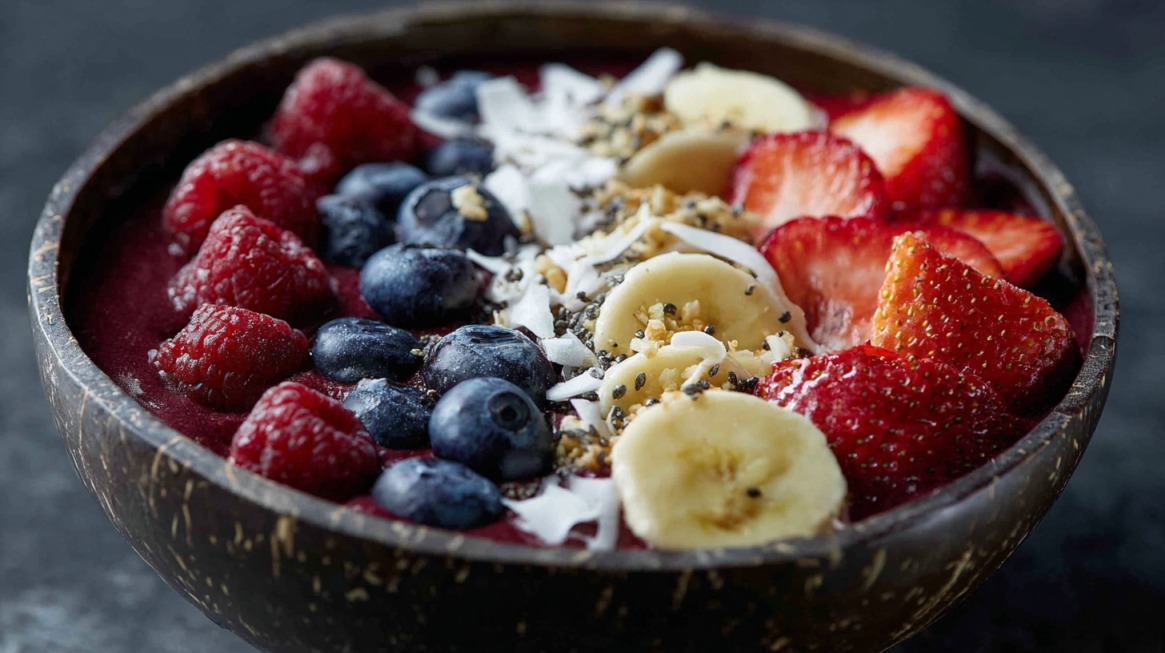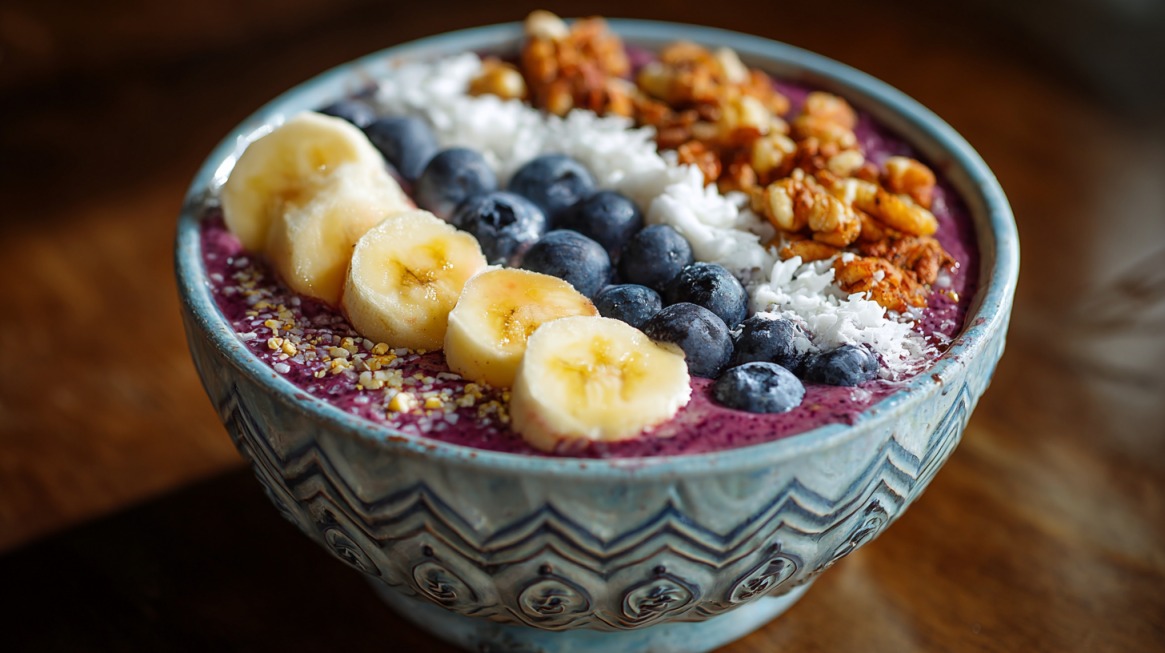Acai bowls have become one of the most photographed foods across social media platforms, often portrayed as colorful, layered creations that symbolize health and vitality.
Their popularity stems not only from aesthetics but also from a general perception that fruit-filled meals automatically equal wellness.
People are drawn to them because of the “superfood” label attached to acai berries, the bright visuals, and the idea that anything fruit-based must be nourishing.
Still, the critical question remains:
Are acai bowls truly a smart nutritional choice, or are they mostly hype dressed up in a pretty package?
What Is Acai, Really?

Acai berries hold an important place in the diets of people living in Central and South America, especially in the Amazon region, where they have been harvested for centuries. Small, round, and deep purple in color, these berries are often praised for their distinctive taste.
Many describe the flavor as earthy with notes reminiscent of unsweetened chocolate or a slightly tart blackberry.
That unusual profile makes acai less sugary than other berries, which is one reason it pairs well with sweeter fruits in bowls and smoothies.
The nutritional profile of acai has gained attention among researchers and health enthusiasts alike.
- Antioxidants: Abundant in anthocyanins, which may reduce oxidative stress in the body.
- Fiber: Supports digestion and helps promote a feeling of fullness.
- Healthy fats: Includes omega-9 fatty acids, which assist in nutrient absorption and satiety.
- Minerals: Contains potassium and calcium, both crucial for muscle and bone health.
- B vitamins: Contribute to energy metabolism and support normal cellular function.
Despite the benefits, fresh acai is rarely available outside its native regions because the fruit spoils quickly.
Instead, international markets rely on processed forms.
@anabolicgabeIs calling out Acai bowls valid?♬ original sound – anabolicgabe
- Frozen puree: The most common base for bowls and smoothies.
- Powder: Often blended into drinks or baked goods for an antioxidant boost.
- Juice: Sometimes mixed with other fruits but frequently contains added sugars, which reduce overall nutritional quality.
What’s Actually in an Acai Bowl?
Acai bowls combine the puree with other ingredients to make them creamy, colorful, and filling. A base usually begins with frozen acai blended into a thick mixture.
Bananas, fruit juices, or sweetened plant-based milks are often added to adjust texture and flavor.
While this makes acai bowls more enjoyable, it also increases sugar and calorie content.
Toppings give acai bowls their vibrant appearance and extra layers of taste.

- Crunchy elements: Granola or toasted oats.
- Natural sweetness: Fresh fruits like berries, mango, or banana slices.
- Healthy fats: Nut butters, chia seeds, flaxseeds, or coconut flakes.
- Flavor boosters: Honey drizzles, cacao nibs, or dark chocolate shavings.
Cafes frequently offer extensive customization options, which can quickly turn a bowl into a calorie-packed dessert rather than a balanced meal. Homemade versions allow more control, letting individuals select healthier toppings, reduce portion sizes, and use unsweetened bases.
The Nutrition Breakdown
Acai on its own remains light in calories while offering fiber and fats.
However, the complete bowl often tells a very different story.
- Unsweetened acai base (100 g): About 70 calories, 5 grams fat, 3 grams fiber, 0 grams sugar.
- Café or store-bought bowl: Often ranges between 200 and 700 calories, sometimes exceeding 80 grams of sugar depending on portion size and added ingredients.
Hidden calories often come from the following:
- Granola clusters sweetened with syrups.
- Large amounts of honey or agave drizzle.
- Dried fruits coated in sugar.
- Oversized servings of nut butters.
Nutrition, therefore, depends largely on preparation choices.
A small, balanced bowl made at home with unsweetened puree and fresh fruit delivers a healthier option compared to commercial offerings, which frequently resemble desserts in terms of sugar load.
View this post on Instagram
Potential Health Benefits of Acai
Acai contains a wide range of compounds that may offer benefits, especially when eaten in reasonable portions. Current research highlights several potential areas of impact:
| Health Area | Potential Benefit |
|---|---|
| Heart health | Antioxidants and healthy fats may improve cholesterol balance and reduce inflammation. |
| Digestive health | Fiber supports bowel regularity and helps maintain a healthy gut environment. |
| Blood sugar regulation | Low sugar in the base fruit and presence of fiber can support steadier blood glucose. |
| Liver and kidney function | Preliminary studies suggest possible protective effects, though more research is needed. |
| Nervous system | Anthocyanins may have a role in brain health and memory support. |
In addition, omega-9 fats assist in absorbing vitamins A, D, E, and K, while also helping people feel full after a meal. These qualities explain why acai is considered nutritionally valuable.
Still, exaggerated marketing claims should be viewed with caution. Weight-loss products that feature acai have little scientific backing, and regulatory agencies have even challenged companies for false advertising.
Acai works best as part of a balanced eating pattern rather than as a miracle cure.
How to Build a Healthier Acai Bowl
Creating a balanced acai bowl depends on intentional choices. Strategies can be grouped into three main areas:
| Category | Strategy/Action | Example/Details |
|---|---|---|
| Improve the base | Use unsweetened frozen puree | Avoid juice or sweetened powders |
| Adjust texture without added sugar | Blend with water, plain almond milk, or frozen berries | |
| Select smart toppings | Add protein | Greek yogurt, cottage cheese, or protein powder |
| Boost fiber | Chia seeds, flaxseeds, or rolled oats | |
| Control healthy fat intake | Limit nuts and nut butters to 1–2 tablespoons | |
| Replace sugary add-ons | Choose homemade or low-sugar granola | |
| Practice portion control | Reduce serving size | Use shallow bowls to limit portions |
| Share or split servings | Divide large café bowls or save half for later | |
| Balance calorie intake | Treat acai bowls as a meal rather than a snack |
Mindful adjustments in preparation allow acai bowls to fit comfortably within a healthy diet.
They can then serve as a refreshing meal that provides antioxidants, fiber, and healthy fats without overwhelming sugar or calories.
The Verdict
Acai bowls can indeed serve as a healthy meal, but everything depends on preparation. A mindful approach that limits added sugars and emphasizes nutrient-dense toppings transforms them into a balanced choice.
On the other hand, oversized servings with sugary additions quickly push them into dessert territory.
Enjoying acai bowls occasionally, built with moderation in mind, allows for both satisfaction and nutritional benefits.
They work best as a colorful, refreshing option that adds variety to an eating routine while avoiding excess sugar and calories.
Hi there, my name is Kelly Barlow and kellytoeat.com is my blog. Here, I write about various recipes I want to reccommend to readers.
I try to find the best possible recipes that can attract the attention of readers, and at the same time, I strive to write it in the most engaging manner possible.
When I was younger, I wanted to become a chef. Sadly, it wasn’t meant to be, but at the very least, I write about it.
